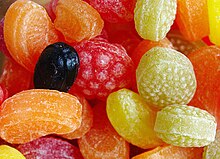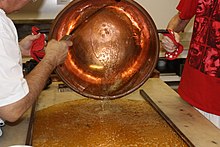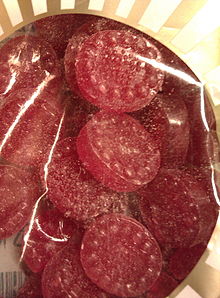Hard candy
 | |
| Alternative names | Boiled sweet |
|---|---|
| Type | Confectionery |
| Main ingredients | Sugarsyrup(sucrose,glucose,orfructose) |
| Variations | Many such ascandy caneorlollipop |
Ahard candy(American English), orboiled sweet(British English), is asugar candyprepared from one or more sugar-basedsyrupsthat is heated to a temperature of 160 °C (320 °F) tomake candy.Among the many hard candy varieties arestick candysuch as thecandy cane,lollipops,rock,aniseed twists,andbêtises de Cambrai."Boiled" is a misnomer, as sucrose (adisaccharide) melts fully at approximately 186 °C. Further heating breaks it into glucose and fructose molecules before it can vaporize.[1]
Most hard candy is nearly 100% sugar by weight, with a tiny amount of other ingredients for color or flavor, and negligiblewater contentin the final product. Recipes for hard candy may use syrups ofsucrose,glucose,fructoseor other sugars. Sugar-free versions have also been created.
Creation[edit]

Recipes for hard candy use a sugar syrup, such as sucrose, glucose or fructose. This is heated to a particular temperature, at which point the candy maker removes it from the heat source and may addcitric acid,food dye,and some flavouring, such as a plantextract,essential oil,orflavourant.The syrup concoction, which is now very thick, can be poured into amoldor tray to cool, or a cooling table in case of industrial mass production. When the syrup is cool enough to handle, it can be folded, rolled, or molded into the shapes desired. After the boiled syrup cools, it is calledhard candy,since it becomes stiff and brittle as it approachesroom temperature.
Chemistry[edit]
Chemically, sugar candies are broadly divided into two groups:crystallinecandies andamorphouscandies.[2]Crystalline candiesare not as hard ascrystalsof the mineral variety, but derive their name and their texture from their microscopically organized sugar structure, formed through a process ofcrystallization,which makes them easy to bite or cut into.Amorphous candieshave a disorganized crystalline structure. Hard candies are non-crystalline, amorphous candies containing about 98% (or more) solid sugar.[3]
Medicinal use[edit]

Hard candies are historically associated withcough drops.The extended flavor release of lozenge-type candy, which mirrors the properties of modern cough drops, had long been appreciated. Manyapothecariesused sugar candy to make their prescriptions more palatable to their customers.[4] They are also carried by people withhypoglycemiato quickly raise their low blood sugar level which, when untreated, can sometimes lead to fainting and other physical complications, and are used as part ofdiabeticmanagement.[5]
Sugar-free[edit]
Hard candies andthroat lozengesprepared withoutsugaremployisomaltas asugar substitute,and are sweetened further by the addition of anartificial sweetener,such asaspartame,sucralose,saccharin,or asugar alcohol,such asxylitol.[6]
In Japan[edit]
Japanese hard candies are known as bekkō ame ( miết giáp di, lit:tortoiseshellcandy). Common legends about theyōkaiKuchisake-onnasay that she can be escaped by distracting her with bekkō ame.[7]
See also[edit]
Confectioners of boiled sweets[edit]
- John Millar & Sons
- Jolly Rancher(now a division ofThe Hershey Company)
- Maxons Ltd, manufacturer ofBlack Bullets
Notes[edit]
- ^"What Are Boiled Sweets".Sugar Stand.Retrieved30 November2022.
- ^McWilliams, Margaret (2007).Nutrition and Dietetics' 2007 Edition.Rex Bookstore, Inc. pp. 177–184.ISBN978-971-23-4738-2.
- ^NPCS (2013).Confectionery Products Handbook (Chocolate, Toffees, Chewing Gum & Sugar Free Confectionery).India: Asia Pacific Business Press. pp. 9–13.ISBN9788178331539.
- ^Oliver, Lynne."FAQs: Candy".The Food Timeline.Retrieved10 March2018.
- ^"How To Treat Hypoglycemia"(PDF).The National Diabetes Education Initiative.The National Diabetes Education Initiative. Archived fromthe original(PDF)on 24 October 2018.Retrieved10 March2018.
- ^Edwards, W. P. (2000).The Science of Sugar Confectionery.Cambridge:Royal Society of Chemistry.ISBN085404593-7.Retrieved20 March2014.
- ^Foster, Michael Dylan (2008-11-03).Pandemonium and Parade: Japanese Monsters and the Culture of Yokai.University of California Press. pp. 185–6.ISBN978-0-520-94267-7.
References[edit]
- "Temporary Metal Fences / Asphalt Shingles / Expanded Polystyrene Products / Hard Candies".How It's Made.Season 3. Episode 4.Science Channel.
- Sherman, Bob."Basic Hard Candy Making Instructions".Williston Park, New York:Bobby's Craft Boutique. Archived fromthe originalon 28 February 2018.Retrieved20 March2011.
